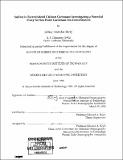| dc.contributor.advisor | Edward A. Boyle. | en_US |
| dc.contributor.author | Berry, Jeffrey Nicholas | en_US |
| dc.contributor.other | Woods Hole Oceanographic Institution. | en_US |
| dc.date.accessioned | 2010-04-07T13:38:15Z | |
| dc.date.available | 2010-04-07T13:38:15Z | |
| dc.date.copyright | 1998 | en_US |
| dc.date.issued | 1988 | en_US |
| dc.identifier.uri | http://hdl.handle.net/1721.1/53536 | |
| dc.description | Thesis (M.S.)--Joint Program in Chemical Oceanography (Massachusetts Institute of Technology, Dept. of Earth, Atmospheric, and Planetary Sciences; and the Woods Hole Oceanographic Institution), 1988. | en_US |
| dc.description | Includes bibliographical references (leaves 82-85). | en_US |
| dc.description.abstract | The sulfur content of planktonic and benthic foraminifera was measured in specimens recovered from deep-sea sediment cores and individuals grown in culture. A new method for measuring sulfur in foraminiferal calcium carbonate was developed, employing a high-resolution inductively coupled plasma-mass spectrometer. The sulfur measurements, expressed as sulfur-to-calcium (S/Ca) ratios in the foraminiferal shells, ranged from 0.26 to 6.0 mmol/mol. Most analyses fell in the range of 0.7 to 2.5 mmol/mol. Culturing experiments were conducted in the planktonic foraminifer G. sacculifer to test the hypothesis that S/Ca ratios in the foraminifer are inversely proportional to the carbonate ion concentration in the seawater in which they grow, and hence proportional to the pH of the seawater. The slope of the relationship between cultured G. sacculifer S/Ca and the pH of the seawater medium was -1.92 mmol mol-1/pH unit with a least squares linear correlation coefficient, r2=0.927. The S/Ca ratios of planktonic and benthic foraminifera from Holocene and last glacial period sediments were measured in an effort to use the established relationship of S/Ca and pH to calculate the ocean pH gradient between Holocene and glacial time. The results indicate the pH of global ocean deepwater was 0.10 to 0.15 pH units higher during glacial time than today. Smaller pH gradients were seen for some cores which may have been caused by circulation-induced water mass changes. Surface ocean changes in pH over the Holocene-glacial interval seem to vary from region to region, with up to an 0.2 pH unit increase at the Sierra Leone Rise in glacial time. Benthic foraminifera from coretops in the thermocline of the Little Bahama Bank were analyzed for S/Ca to examine the effects of hydrographic variables on S/Ca. The relationship of S/Ca to pH and [CO3=] has a positive slope, at odds with the expected negative slope from the previous results. The S/Ca results do correlate well with salinity, suggesting that salinity or other hydrographic parameters may also influence foraminiferal S/Ca ratios. | en_US |
| dc.description.statementofresponsibility | by Jeffrey Nicholas Berry. | en_US |
| dc.format.extent | 88 leaves | en_US |
| dc.language.iso | eng | en_US |
| dc.publisher | Massachusetts Institute of Technology | en_US |
| dc.rights | M.I.T. theses are protected by
copyright. They may be viewed from this source for any purpose, but
reproduction or distribution in any format is prohibited without written
permission. See provided URL for inquiries about permission. | en_US |
| dc.rights.uri | http://dspace.mit.edu/handle/1721.1/7582 | en_US |
| dc.subject | Joint Program in Chemical Oceanography. | en_US |
| dc.subject | Earth, Atmospheric, and Planetary Sciences. | en_US |
| dc.subject | Woods Hole Oceanographic Institution. | en_US |
| dc.subject.lcc | GC7.8 .B47 | en_US |
| dc.subject.lcsh | Foraminifera | en_US |
| dc.title | Sulfate in foraminiferal calcium carbonate : investigating a potential proxy for sea water carbonate ion concentration | en_US |
| dc.type | Thesis | en_US |
| dc.description.degree | M.S. | en_US |
| dc.contributor.department | Joint Program in Chemical Oceanography | en_US |
| dc.contributor.department | Woods Hole Oceanographic Institution | en_US |
| dc.contributor.department | Massachusetts Institute of Technology. Department of Earth, Atmospheric, and Planetary Sciences | |
| dc.identifier.oclc | 40227105 | en_US |
